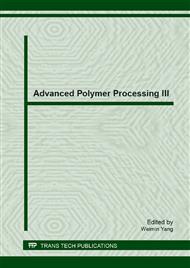p.19
p.25
p.30
p.36
p.41
p.47
p.54
p.59
p.64
Research on Properties of AROPOL G102 / Clay Nanocomposites
Abstract:
Unsaturated polyester resins are widely used in the manufacture of fiber reinforced plastics and shipbuilding industry. Their undesirable mechanical property may bring about disadvantages. The nanoparticles were added to the polymer material, which will strengthen the performance of the polymer material. AROPOL G102 / Clay Nanocomposites were prepared by magnetic stirring apparatus at room temperature. The result showed that nano-montmorillonite can effectively increase the mechanical property of the material.
Info:
Periodical:
Pages:
41-46
Citation:
Online since:
July 2013
Authors:
Keywords:
Price:
Сopyright:
© 2013 Trans Tech Publications Ltd. All Rights Reserved
Share:
Citation:


